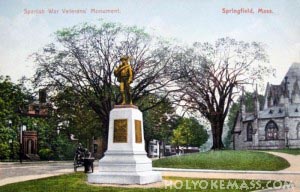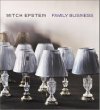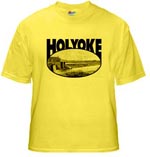by Laurel | April 8th, 2010
Five (actually a few more, but you can read about that in the article below) Holyoke men died as a result of the Spanish American War and — according to the article below — were to be honored by having their names included on the monument. In the article, the monument was proposed and did not yet exist. I have the postcard, above, in my western MA postcard collection, so it looks like the monument was erected. I should know where this is but I do not, even though the church is familiar. I’ll have to look through my paper collection on Springfield to see what I can find. Anyone know where this monument is today? I’d like to stop and take some pictures of it next time I am in the area.
April 8, 1906, page 15
Their Names on the Tablet
On the 2d Regiment Monument to be Erected in Springfield.
When the monument that is assured will be erected by the 2d regiment in honor of the men who perished in the Spanish-American war is completed it will bear tablets for the names of nearly 100 men who either died in the fighting tanks or of fever or other disease contracted in the service. Thirty days elapsed between the return home and the mustering out, and other deaths and many lifelong reminders of the campaign can be charged up to the climate as well as the enemy’s bullets — the latter being less feared. Holyoke’s Co. D will have the named of five men on these tablets. In justice, the names of one or two others who died later from disease contracted in Cuba ought to be included, but the line must be drawn somewhere.
Both by rank and seniority, Edgar R. Train, quartermaster-sergeant, holds first place.. Sergeant Train had been a member of Co D for about 20 years. He was a member of the old “Co K” of Holyoke and had withdrawn from Co D the year before the war broke out. He was 2d lieutenant at the time of his withdrawal, but rather than be left behind when the call came he re-enlisted, and was made quartermaster-sergeant. His death took place at Montauk Point on the return home. He was accorded a military funeral in one of the Holyoke churches, the first of the Holyoke victims to be accorded that honor. Sergeant George Collier died of what the boys termed “mad fever” shortly after reaching home. He was one of the wrecks that climbed off from the train that brought back the militiamen from this section. Those who saw that train come in and the haggard, deep-lined faces will never forget it. Some of the men had to be helped or carried from the train to carriages. Young Collier had a fine position in one of the mills, and a bright future, which was cut short by Cuba miasma. Sergeant Frank Mattice, one of the brightest and most popular of the “noncoms,” was home for about a week before he succumbed to malarial fever. He was the only son of Ira F. Mattice, and also a young fellow of much promise. He was taken sick in Santiago.
Of the five Co D deaths, but one, that of Antone Dugas, was from a bullet. A Mauser from the Spanish lines struck his cartridge belt and exploded one o his bullets, which tore its way into his abdomen. He lived about 10 hours, in great agony for the larger part of the time. He, too, was a young man with excellent prospects, and when he enlisted was studying to be a dentist. The fifth and last, Joseph Bonneville, or “Bonnie” as he was nicknamed, died at Santiago of malarial fever. He had previously been transferred from regular service to hospital duty, and while in that work contracted the fever. “Bonnie” was by common consent the best humored man in the company. He never got offended at the roughest horseplay and his broken English was a source of much amusement to the men. The bodies of all these five who died away from home were brought back to Holyoke, their graves are marked each ear–formerly by a detail from Co D. and since the organization of the Nelson A. Miles camp, Legion of Spanish war veterans, that organization has assumed charge of the work. So not only by their relative and friends but publicly each year is their memory kept fresh, as it is befitting. For they risked all as bravely and cheerfully and faced a deadlier foe than the Spanish bullet in the Cuban fevers.
From The Springfield Republican.









